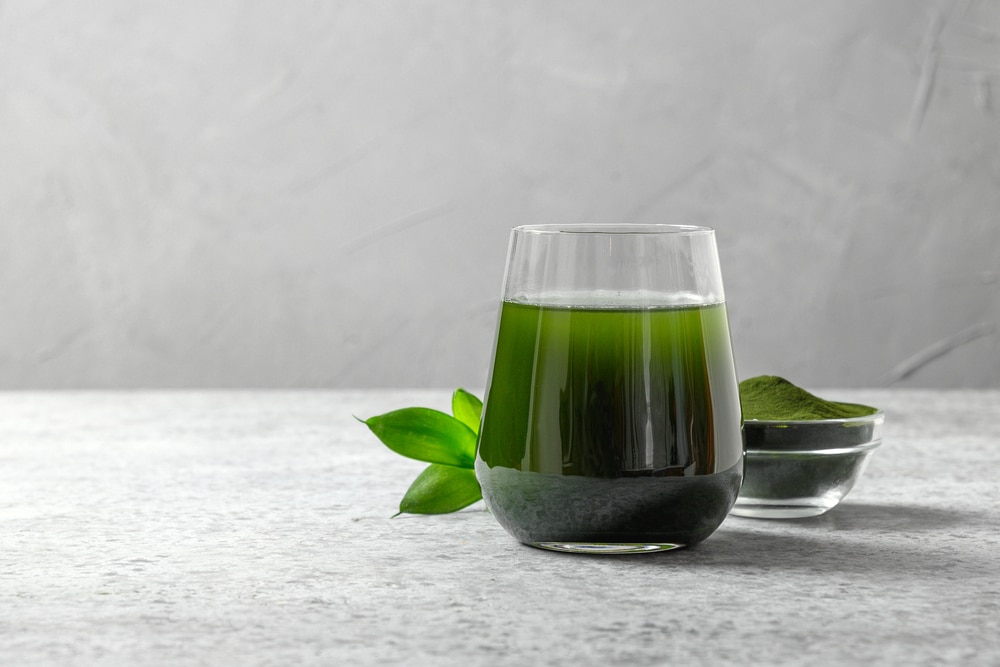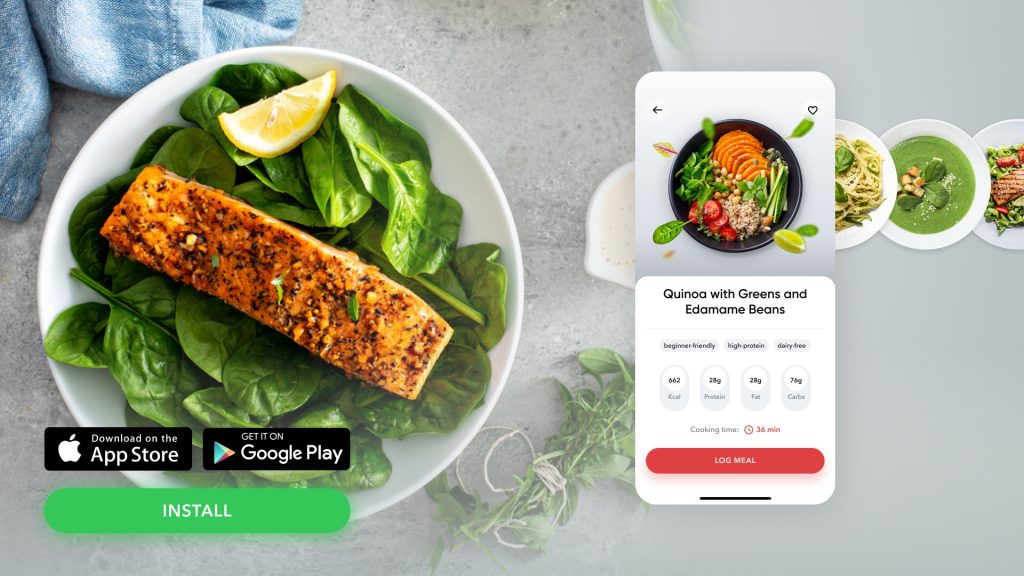Liquid chlorophyll is all the craze these days. It’s touted as a drink with many benefits, including detoxification of the body, acting as an internal deodorizer, boosting energy, and improving circulation. That said, does it live up to its reputation? Or is it another fad in a long line of facial creams and drinks with impossible-to-pronounce ingredients? There are many potential benefits, along with some risks when consuming liquid chlorophyll. In this article, we will go over the benefits, risks, and everything else you should know before buying liquid chlorophyll.
What Is Chlorophyll?
In its basic form, chlorophyll is a green pigment that is also found in plants, cyanobacteria, and algae. It is responsible for photosynthesis, which is the process of turning light energy from the sun into chemical energy used by the plant to produce sugars and oxygen (9).
It contains vitamins and antioxidants that make it beneficial for human health.
Liquid chlorophyll is just an extract of the pigment that gives plants their green color. It has been used as a coloring agent for decades, but its recent use as a dietary supplement has brought it back into popularity (4).
Liquid chlorophyll can be found in many health food stores and some pharmacies. It is commonly found in liquid form but can also be added to juices and smoothies.
Liquid chlorophyll is made by extracting the pigment from alfalfa leaves, wheatgrass, or another type of chlorophyll-containing plant. The extracts are then purified so that impurities are removed.
Research results are mixed on the exact benefits of taking these supplements and more rigorous studies are needed.
Read More: Spirulina Calories, Health Benefits, And Side Effects
Benefits Of Liquid Chlorophyll
Liquid chlorophyll has many benefits. These have been documented in some scientific studies. Here are the benefits that are known so far:
Skin Healing
Taking a chlorophyll drink for the skin might be a good idea due to its anti-inflammatory and wound-healing properties. A review of the evidence on the effects of chlorophyll used to debride wounds found that it may be helpful in healing wounds, ulcers, and burns (11).
Hemoglobin Production
Eating lots of leafy green vegetables is often recommended to boost iron intake (16). However, this isn’t always possible due to taste or intolerance issues. Chlorophyll is chemically similar to hemoglobin, and it has been suggested that taking it as a supplement might be helpful in treating hemoglobin disorders. This is far from proven, however.
Improved Gut Health
Liquid chlorophyll may have prebiotic benefits. Prebiotics are beneficial for gut health by promoting the growth of “good” bacteria in the intestines. (1)
Detoxification And Cancer
Some claim that liquid chlorophyll can help get rid of toxins from the body due to its metal-binding properties (6). It might also have anti-mutagenic benefits, decreasing the amount of oxidative damage in the body that is thought to contribute to cancer development (8).
Studies investigating the effect of chlorophyll on cancer cells have only been done in animals (3). More research is needed to make conclusions as to the potential of this ingredient to prevent or slow down cancer progression.
Weight Loss
One of the purported benefits of liquid chlorophyll is that it helps you lose weight. This claim hasn’t been sufficiently proven.
One study involving female participants found that those who took a green plant membrane supplement (which includes chlorophyll) had greater weight loss than the group that didn’t. Researchers suggest that the supplement may also have reduced harmful cholesterol levels (2).
Reasons why BetterMe is a safe bet: a wide range of calorie-blasting workouts, finger-licking recipes, 24/7 support, challenges that’ll keep you on your best game, and that just scratches the surface! Start using our app and watch the magic happen.
Risks Of Liquid Chlorophyll
Although liquid chlorophyll has many benefits, there are some risks associated with it as well (7). These include:
Diarrhea
Stop taking chlorophyll supplements if you experience abdominal pain or diarrhea.
Green Stool
Taking too much liquid chlorophyll might turn your stool green. This discoloration is not harmful.
Allergic Reactions
Some people may experience an allergic reaction when taking liquid chlorophyll. The symptoms include:
- Hives
- Rashes
- Itchy skin or mouth
- Swelling of lips, mouth, and throat
- Nausea, vomiting, and diarrhea may also occur.
Read More: Blue Spirulina Facts, Health Benefits And Side Effects
Alternatives To Liquid Chlorophyll
With limited research, mixed results, and side effects associated with liquid chlorophyll, it may not be the best option to improve health. It might be a good idea to consider other green foods that have similar benefits without the risks. The following are some alternatives:
Leafy Greens
There are tons of green foods that contain chlorophyll such as kale, Swiss chard, beet greens, alfalfa sprouts, spinach, and parsley. Eating a variety of these vegetables might be a more effective way to get the benefits chlorophyll has to offer.
Leafy greens also offer fiber, antioxidants, and other nutrients.
Green Drinks
There are also green drinks that contain chlorophyll from plants such as barley grass, wheatgrass, alfalfa sprouts, oat grass, basil leaves, and parsley. There is a long list of possible benefits associated with these drinks that include (5):
- Improved heart health
- Immune system support
- Increased energy
- Clearer skin
- Improved digestion
The downside for some people is that these drinks may taste bad or have a grassy aftertaste. However, some companies offer green drinks in flavors such as grapefruit, orange, and vanilla. They might contain added sugar, but they can still be a good option for getting the benefits of chlorophyll.
BetterMe app will provide you with a host of fat-frying fitness routines that’ll scare the extra pounds away and turn your body into a masterpiece! Get your life moving in the right direction with BetterMe!
Iron-Rich Foods
Getting enough iron in your diet is important. Your body uses it to transport oxygen around the body, which is how you feel energized and alive (12). Meat, seafood, beans, leafy greens, tofu, and dried fruit are great sources of this mineral.
Chlorella
In addition to ingesting chlorophyll, some people have turned to taking chlorella supplements. Chlorella is an edible single-cell green alga that has been linked to improved digestion, increased energy, and improved cardiometabolic risk factors (15).
The Bottom Line
Liquid chlorophyll has been promoted as a way to improve health. However, there has not been enough research conducted on humans to determine the effectiveness and safety of using liquid chlorophyll as a dietary supplement.
Get your personalized
meal plan!
DISCLAIMER:
This article is intended for general informational purposes only and does not serve to address individual circumstances. It is not a substitute for professional advice or help and should not be relied on for making any kind of decision-making. Any action taken as a direct or indirect result of the information in this article is entirely at your own risk and is your sole responsibility.
BetterMe, its content staff, and its medical advisors accept no responsibility for inaccuracies, errors, misstatements, inconsistencies, or omissions and specifically disclaim any liability, loss or risk, personal, professional or otherwise, which may be incurred as a consequence, directly or indirectly, of the use and/or application of any content.
You should always seek the advice of your physician or other qualified health provider with any questions you may have regarding a medical condition or your specific situation. Never disregard professional medical advice or delay seeking it because of BetterMe content. If you suspect or think you may have a medical emergency, call your doctor.
SOURCES:
- Beneficial Properties of Probiotics (2016, ncbi.nlm.nih.gov)
- Body weight loss, reduced urge for palatable food and increased release of GLP-1 through daily supplementation with green-plant membranes for three months in overweight women – ScienceDirect (2014, sciencedirect.com)
- Cancer chemoprevention by dietary chlorophylls: A 12,000-animal dose-dose matrix biomarker and tumor study (2012, ncbi.nlm.nih.gov)
- Chlorophyll and Chlorophyllin (2004, lpi.oregonstate.edu)
- Chlorophyll and total phenolic contents, antioxidant activities and consumer acceptance test of processed grass drinks (2016, ncbi.nlm.nih.gov)
- Chlorophyllin intervention reduces aflatoxin–DNA adducts in individuals at high risk for liver cancer (2001, ncbi.nlm.nih.gov)
- Chlorophyllin Uses, Side Effects & Warnings (n.d., drugs.com)
- Chlorophyll-Mediated Changes in the Redox Status of Pancreatic Cancer Cells Are Associated with Its Anticancer Effects (2018, hindawi.com)
- Chloroplasts and Photosynthesis – Molecular Biology of the Cell (2002, ncbi.nlm.nih.gov)
- Comparisons of Curative Effects of Chlorophyll from Sauropus androgynus (L) Merr Leaf Extract and Cu-Chlorophyllin on Sodium Nitrate-Induced Oxidative Stress in Rats (2016, hindawi.com)
- Enzymatic Debriding Agents: An Evaluation of the Medical Literature (2008, hmpgloballearningnetwork.com)
- Iron (2021,ncbi.nlm.nih.gov)
- Iron Toxicity – StatPearls – NCBI Bookshelf (2021, ncbi.nlm.nih.gov)
- Optimizing fat oxidation through exercise and diet – ScienceDirect (2004, sciencedirect.com)
- Potential of Chlorella as a Dietary Supplement to Promote Human Health (2020, mdpi.com)
- Potential of Traditionally Cooked Green Leafy Vegetables as Natural Sources for Supplementation of Eight Micronutrients in Vegetarian Diets – ScienceDirect (2000, sciencedirect.com)
- The Medical Use of Wheatgrass: Review of the Gap Between Basic and Clinical Applications (2016, pubmed.ncbi.nlm.nih.gov)
- Vitamin B6 (Pyridoxine) (2021, ncbi.nlm.nih.gov)










